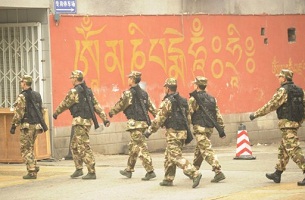Tibet: 'Military camps' set up in Kardze
| Publisher | Radio Free Asia |
| Publication Date | 25 May 2012 |
| Cite as | Radio Free Asia, Tibet: 'Military camps' set up in Kardze, 25 May 2012, available at: https://www.refworld.org/docid/4fc8ad69c.html [accessed 1 June 2023] |
| Disclaimer | This is not a UNHCR publication. UNHCR is not responsible for, nor does it necessarily endorse, its content. Any views expressed are solely those of the author or publisher and do not necessarily reflect those of UNHCR, the United Nations or its Member States. |
2012-05-25
Chinese authorities strengthen their security forces in a restive Tibetan region.
 Armed Chinese PLA soldiers walk down a street with Tibetan writing on the wall in Chengdu in Sichuan province on Jan. 27, 2012. AFP
Armed Chinese PLA soldiers walk down a street with Tibetan writing on the wall in Chengdu in Sichuan province on Jan. 27, 2012. AFP
Chinese security forces have set up two new bases in a Tibetan-populated county in Sichuan province to guard against mass protests, adding to an already heavy armed presence in the troubled region, sources said.
The bases were set up recently in Kardze (in Chinese, Ganzi) county in Sichuan and comprise hundreds of "soldiers," a Tibetan resident of the area said this week. Â
One camp was set up in a Tibetan school, forcing its closure, the source said.
"Recently, two new Chinese military camps were established in Kardze county in Sichuan," the source said, speaking on condition of anonymity.
"One of these was set up in the compound of the Kardze Tibetan Language Middle School, which was then forced to close," the source said.
"The other was set up at a place called Shisur, the site of a gas station in Kardze town close to the highway that leads from Kardze to [the Tibetan regional capital] Lhasa."
"Each of these two camps has hundreds of soldiers," the source said.
Since protests challenging Chinese rule swept across Tibetan regions in 2008, "26 new military camps have been set up within the jurisdiction of Kardze county," he said.
"There are seven in the area of the Tongkor subdivision, and 17 around Kardze town."
Sichuan's Kardze county, and its larger Kardze prefecture, have been the scene of repeated protests in recent months by Tibetans challenging rule by Beijing, including many of the 35 self-immolation protests reported in Tibetan regions since February 2009.
These have resulted in a major security crackdown in the province and in two other Tibetan-populated Chinese provinces, Qinghai and Gansu, as well as in the Tibet Autonomous Region.
'Both are there'
Both China's People's Liberation Army (PLA) and its paramilitary People's Armed Police (PAP) have bases in Kardze and in other Tibetan-populated regions of western China, with the PAP given primary responsibility for maintaining public order, analysts say.
"People watching the camps have observed that exercises conducted there involve combating protests and mass rallies," the Tibetan source said.
"[Personnel] have been seen practicing the use of different devices used to restrain, beat, and launch surprise attacks on Tibetan protesters," he added.
A government analyst and expert on Tibet called the probability "extremely high" that the personnel observed in the exercises were not regular troops, but members of the People's Armed Police.
"For one thing, crowd control is a key function for them. Domestic activity like that is definitely not a key PLA function."
In serious protest or riot situations, though, the PAP might sometimes use PLA hardware, and vehicle license plates are sometimes covered, he said.
Rinchen Tashi, a China analyst at the Washington-based International Campaign for Tibet, confirmed the presence of both PAP and PLA bases in the Kardze region.
"Both are there, and their numbers are increasing," he said, noting China's growing concern with Kardze as a politically sensitive area.
"And since last year, the situation has become even worse."
"Right now, if you are a Tibetan with an ID from Kardze prefecture, and you go to Lhasa and want to drive home from Lhasa to Kardze, you cannot stop overnight at any hotel on the way or even stay with people you know," he said.
"You have to keep driving until you reach the territory of Kardze prefecture," he said.
Speaking separately, Columbia University Tibet scholar Robbie Barnett noted a "sharp increase" in security spending per person in Kardze and neighboring Ngaba (in Chinese, Aba) prefectures since 2006.
"So that by 2009 in those two prefectures it was around four times the average per capita for Sichuan as a whole, with spending for Kardze even higher than for Ngaba."
Security spending in the prefectures included funding for the PAP and Public Security Bureau, but not for the PLA itself, Barnett said.
Reported by Norbu Damdul for RFA's Tibetan service. Translations by Karma Dorjee. Written in English with additional reporting by Richard Finney.
Link to original story on RFA website
